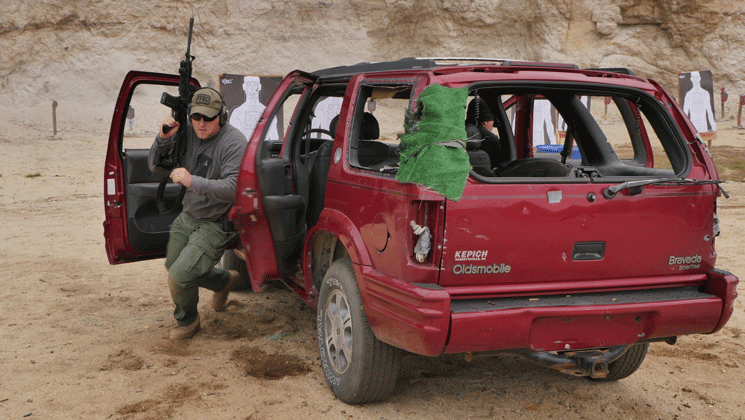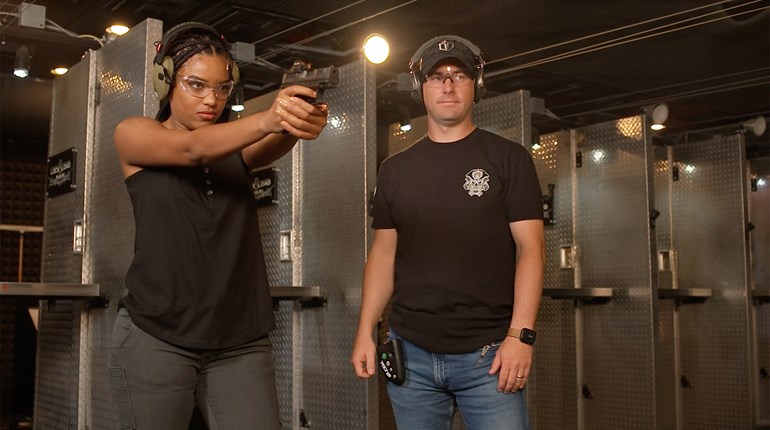
I spend a lot of time thinking and frankly, worrying about how I train myself and what I teach students in my defensive-handgun classes. It weighs heavy on my mind because the stakes are high. A defensive gun-use error can be costly. If you err on the side of excess you are risking your freedom, your financial security and all the consequences that come with a violation of the law, morals and/or ethics.
If instead you act without enough conviction you risk injury or death to yourself or another innocent person. Either way, the stakes are significant.
Imagine that moment in a dark parking lot when everything is on the line. A violent criminal proposes the option, “Your wallet or your life.” It seems like an easy choice. If you could trust them with their word it would be. You and I both know it just isn’t that simple.
Speed and precision could be factors.
It comes down to your decision.
Your decision in this very unreasonable situation, “your wallet or your life,” must be reasonable. The challenge is, it’s virtually impossible to be able to armchair this kind of a decision ahead of time. Like most decisions in life, it would be easier to know what to do with a boat load of experience, but as Marshall Mathers said, “You only get one shot…”
Making the no go/go decision efficiently seems like a skill we would want to improve. The more proficient we become at recognizing important information, the more quickly and accurately we are able to decide our course of action. The sooner we are headed in the right direction, the more likely we are to be able to capitalize on an opportunity our attacker provides us. The longer it takes us to make the choice, the fewer options we have.
Maybe more importantly making a quality decision early provides us an opportunity to seize the initiative and shift toward action instead of reaction.
Clearly, if we want to be better at personal protection it makes sense that we would strive to improve our decision-making skills in this arena.
When was the last time that you gathered information and used that information to make a decision in defensive firearms training?
We improve what we measure.
In defensive shooting, as in most other things in life, we improve what we measure. It won’t surprise you to find out that we tend to measure what is easy to gauge. On the range, we have tools that can easily help us measure two factors, speed and accuracy.
Speed is measured with a fancy shot timer that provides a start signal and records the elapsed time to each gunshot. This can easily be done with just an app on your phone.
Accuracy is even easier. With the simple use of a target with concentric scoring rings we can measure both accuracy and precision.
We know we are getting serious when we put the two together. Assigned scoring values that increase with increased accuracy provide a shooters points. Combining those points with the elapsed time provides a point-per-second ratio that allows us to compare ourselves against others and even ourselves on comparable courses-of-fire.
We have invested a significant amount of energy into scoring our shooting. We even hang our hat on those scores with names for rankings like Expert or Master. These titles matter, but do they have the weight we think they do when it comes to defending yourself with a gun?
Is it possible that we are setting up our training and practice to feel good about ourselves instead of actually getting better at defensive shooting?
Confidence, competence and their twisted relationship.
The words sound the same, but they have very different meanings. Confidence is what you believe that you can do. Competence on the other hand is what you actually can do, reliably.
In a perfect world our confidence and our competence would be matched. We would believe that we can do what we can actually do. Often it doesn’t work that way.
In fact, it can be exactly the opposite. Many shooters have a confidence that is significantly greater than their actual ability. They believe they can shoot at a level which they don't begin to approach.
Imagine the problems this mismatch can cause. Shooters engaging targets too quickly when they are too far away and too small to hit with the skill set they possess. This is a significant liability in a world where you are responsible for every round.
Simple problem.
I’ve been conversing with folks who know more than me about this issue. They should know more because the people they spend time training are seeking out the scenarios some of us prepare for, but all hope we never face.
The tactical units of not the largest, but the most famous, federal LE agency generally agree that overconfidence is the result of overly simple training. In fact, they break it down something like this:
Simple training leads to high confidence and low competence.
Complex training leads to low confidence and high competence.
Think about that for a moment. When it comes to winning at personal protection do you want to be the person that is all talk and no game?
If you spend the majority of your training time running preplanned drills you are training simply. Your skills will develop, but what remains un-nurtured is your understanding of when, where, why and how these skills should be applied. You will have confidence in your ability to defend yourself, but your actual ability to do so will remain low.
Being able to throw a line drive to the back of the end zone is an important skill for a quarterback. This skill needs to be taught, practiced and drilled. If, however, you stop with the drills, you are not going to have a winning season.
Complex solution.
The solution isn’t simple. Instead, it’s complex, but not the kind of complex you think I mean.
What needs to be complex is our training.
When we are working with a gun in our hand (or in any skill at all really) we want that time to be rich with variables and full of decisions that need to be made.
This approach to training forces us to focus not only on our skills, but also on when, where, why and how those skills should be applied.
At the same time, something different happens with our confidence when we develop as thinkers instead of shooters. Our confidence takes a hit. This may be one of the reasons shooters and instructors both tend to avoid complex, variable-filled training.
Making decisions in complex scenarios just doesn’t feel as good as drilling the x-ring at speed.
We can’t afford to avoid it. It would be like the QB coach not forcing his quarterback to work against an active defense in practice. That solid throwing arm needs to be coupled with the brain that knows how to recognize what is happening on the playing field and is able to decide when to throw or when to run.
Our focus is what matters.
The vast majority of measurement that happens on the range is targeted at helping shooters get hits on the target quickly.
This focus on measuring fast, accurate shooting drives improvement in our shooting skills. Skills, however, aren’t the whole picture. Remember, those skills should only be put into play after we have recognized the scenario, identified a potential solution and decided to solve the problem. That is when our skills matter.
I’m not suggesting for a second that we shouldn’t be proficient in our skills. We should work to be accurate and fast, but not to the exclusion of all else. Instead we should become moderately proficient with our skills and then shift our focus to understanding the complexities of defensive scenarios and the recognition and decision-making skills we need to be problem solvers. In this stage of our training we can develop our skills and our tactics together.
What can you do?
Failure hurts. This is why most people avoid it. But, because of the pain failure has the potential to teach. Those lessons are only available to folks that are willing to learn. Be one of those people that is willing to fail in training. Seek out trainers that help you to develop skills and then provide you with the opportunity to safely make mistakes in a variable-rich environment that is filled with decision-making opportunities.
Taking this step and these kinds of classes is likely to leave you frustrated at times. What you may not realize is how far ahead you leap in actual competence. Or, if you want to be stagnant and feel good about yourself go run some more drills and shave another tenth off your draw. The choice is yours. Either way, I’ll see you at the range. I’ll probably be the guy failing in training and weeping in the corner...






































